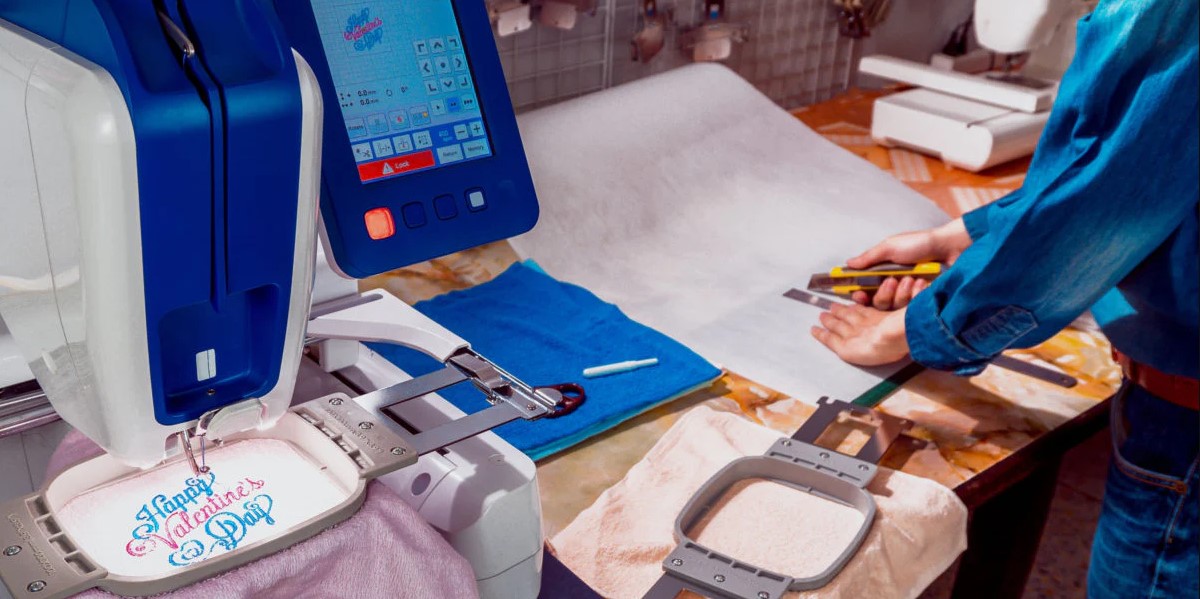If you’ve ever done machine embroidery and ended up with puckered fabric, distorted stitches, or a design that just didn’t sit right—you’re not alone. The culprit? You probably skipped the right stabilizer.
Embroidery stabilizers might not seem like the star of the show, but trust us—they’re the backbone of clean, professional embroidery. Using the correct stabilizer ensures your design stays flat, aligned, and looking polished.
In this guide, we’ll break down the five main types of embroidery stabilizers, explain what makes each unique, and help you figure out which one to use for your specific project.
Looking to get your designs digitized for embroidery machines? Digitizing Buddy converts any artwork into machine-ready files with precise stitch paths—perfectly optimized to work with your chosen stabilizer and fabric type!
What Is an Embroidery Stabilizer?
An embroidery stabilizer is a backing (or sometimes a topping) material that supports your fabric during the embroidery process. It prevents:
- Fabric stretching
- Stitch misalignment
- Puckering or wrinkling
- Uneven or sagging thread tension
Once the embroidery is done, the stabilizer either stays in place (for structure) or is removed.
Think of it as the invisible support that makes your stitches shine.
The 5 Main Types of Embroidery Stabilizers
Let’s look at the big five, what they’re made of, and when to use them.
1. Tear-Away Stabilizer
What It Is:
Tear-away stabilizers are lightweight materials that rip away easily after stitching. They’re quick and mess-free.
Best For:
- Stable woven fabrics (like denim, twill, canvas)
- Simple, low-density designs (logos, monograms)
- Projects where you don’t want permanent backing
Pros:
- Easy to remove
- Great for fast, simple designs
- Leaves no stiffness behind
Cons:
- Not good for stretchy or delicate fabrics
- Can cause distortion if torn carelessly
When to Use:
Use tear-away when you want support during stitching but don’t need long-term structure—like on napkins, towels, or hats.
2. Cut-Away Stabilizer
What It Is:
Cut-away stabilizers are permanent backings that you trim with scissors after stitching. They stay with the fabric to support it over time.
Best For:
- Stretchy or unstable fabrics (jersey, fleece, knits)
- High-stitch-count or dense embroidery
- Apparel that gets worn and washed often
Pros:
- Excellent long-term support
- Prevents distortion in stretchy fabrics
- Ideal for detailed logos and text
Cons:
- Takes more time to trim
- Adds bulk behind the embroidery
When to Use:
Go with cut-away stabilizers for t-shirts, sweatshirts, hoodies, and anything made of stretchy or flexible fabric.
3. Water-Soluble Stabilizer (WSS)
What It Is:
WSS dissolves in water after stitching, leaving no trace behind. It’s either a topping (clear film) or a mesh-type stabilizer.
Best For:
- Embroidery on sheer or lace fabrics
- Towels or terry cloth (as a topping)
- Free-standing lace designs
- Heirloom sewing or delicate bridal wear
Pros:
- Leaves fabric completely clean
- Great for delicate or see-through fabrics
- Topping prevents stitches from sinking into textured fabric
Cons:
- Requires careful washing or soaking
- Not suitable for high-stitch-count designs alone
When to Use:
Use WSS as a topper on towels and textured fabrics or as a backing for sheer projects like lace, organza, or tulle.
4. Heat-Away Stabilizer
What It Is:
Heat-away stabilizers melt when exposed to a hot iron, leaving no residue behind.
Best For:
- Fabrics that can’t get wet (leather, velvet, metallics)
- Projects where water-soluble stabilizers aren’t an option
Pros:
- Leaves no trace
- Ideal for dry-clean-only fabrics
- Perfect for tricky textures like velvet
Cons:
- Requires precision with heat
- Can damage fabric if overheated
When to Use:
Use heat-away for specialty fabrics where water might cause damage, like velvet, suede, or metallics.
5. Adhesive (Sticky) Stabilizer
What It Is:
This stabilizer has a sticky surface that holds fabric in place without hooping. It comes in both tear-away and wash-away versions.
Best For:
- Hard-to-hoop items (hats, collars, sleeves)
- Small or oddly shaped garments
- Delicate or stretchy fabrics that can’t handle a hoop
Pros:
- No hoop marks
- Great for embroidery on ready-made garments
- Ideal for patches and applique
Cons:
- Can leave adhesive residue if not used carefully
- Requires skill to align perfectly
When to Use:
Use adhesive stabilizer when hooping isn’t practical—onesies, socks, cuffs, bags, and structured caps.
Bonus: Fusible Stabilizers
Some tear-away and cut-away stabilizers also come in fusible versions that you iron onto the fabric for extra support before stitching.
These are great when you need extra help keeping fabric from shifting or stretching during hooping.
How to Choose the Right Stabilizer
Here’s a quick reference table to help you decide:
| Fabric Type | Best Stabilizer | Notes |
| Cotton/Twill | Tear-away | Use medium or light-weight |
| Stretchy T-Shirts | Cut-away | Medium weight + fusible helps |
| Fleece | Cut-away + topping | Prevents sink-in stitching |
| Towels | Tear-away + WSS top | Topping keeps stitches clean |
| Lace/Organza | Water-soluble | Mesh or film-type WSS |
| Leather/Velvet | Heat-away | Test heat on fabric first |
| Baby Onesies | Cut-away + sticky | Avoid hooping distortions |
| Caps/Hats | Sticky or tear-away | Stabilize for curve properly |
Pro Tips for Stabilizer Success
1. Match Stabilizer to Stitch Count
- Light designs = light stabilizer
- Dense designs = medium or heavy stabilizer
2. Don’t Over-Stabilize
Too much backing can make your embroidery stiff and uncomfortable, especially on garments.
3. Hooping Matters
Make sure the stabilizer is hooped smoothly with the fabric. Wrinkles or loose areas will show in the stitches.
4. Test on Scrap First
Always test your combo of fabric + stabilizer + design before stitching on the final item.
5. Keep a Stabilizer Stash
It’s helpful to keep a few types on hand so you’re always prepared for different projects.
Frequently Asked Questions
Can I use the same stabilizer for every project?
Not really. Stretchy fabrics, textured materials, and heavy designs all need different stabilizer types to stitch properly.
What’s the best stabilizer for beginners?
Medium-weight tear-away or cut-away is a good start. Easy to use, works on most fabrics, and gives decent support.
Do I need stabilizer with pre-embroidered fabrics?
Yes! Even if the fabric looks strong, it still needs stabilization during stitching to prevent distortion.
Is it okay to use multiple stabilizers at once?
Absolutely. It’s common to combine a cut-away with a water-soluble topper, or fusible stabilizer with sticky backing for tricky fabrics.



